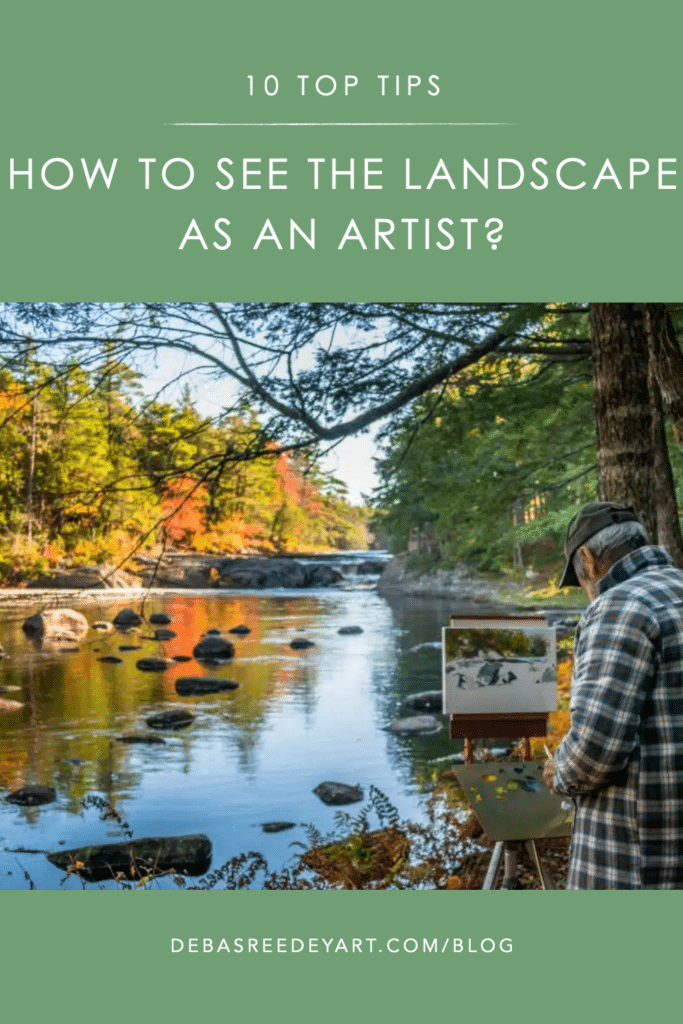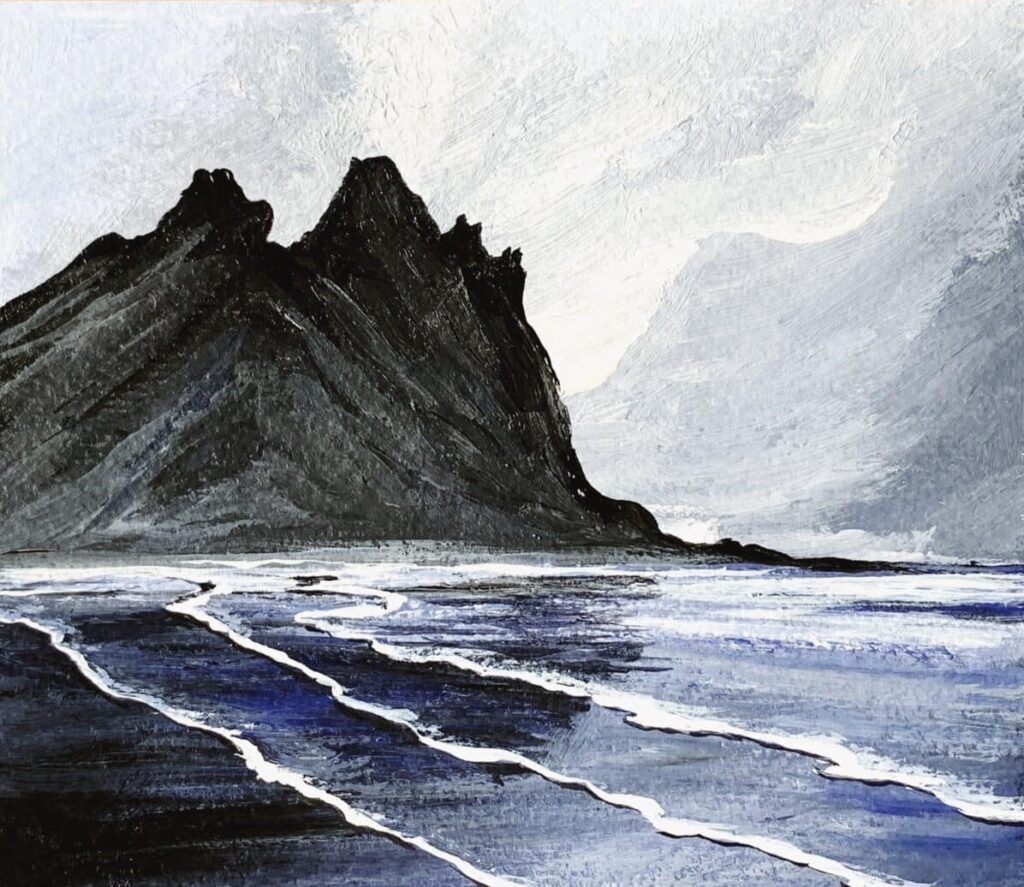The natural world has always been a profound source of inspiration for artists, beckoning them to capture its breathtaking beauty on canvas. Yet, what sets apart a skilled landscape artist from a casual observer?
It all begins with the ability to see the landscape through an artist’s eyes.
As artists, one of our greatest assets is our ability to see the world with a unique perspective.
When it comes to landscapes, training our eyes to perceive beyond the surface level is essential for capturing the essence and translating it onto the canvas.
In this comprehensive guide, we will explore the techniques, mindset, and practices necessary to truly see the landscape as an artist does.
1. Slow down and observe
In a fast-paced world, it’s crucial to cultivate mindfulness and embrace the art of slowing down.
By taking the time to truly observe your surroundings, you can immerse yourself in the landscape and develop a deeper connection with it.
Pause, breathe, and let yourself soak in the details of the landscape.
Pay attention to the way light interacts with different elements, casting shadows, and creating highlights. Develop a heightened awareness of the small details as well as the overall scene. This level of observation will enable you to capture the intricacies of the landscape more effectively.
Train yourself to see beyond the obvious and discover the hidden beauty in the ordinary.
2. Simplify & Study the elements
Landscape scenes can often be complex and overwhelming, with an abundance of visual information. To avoid getting overwhelmed, it can be helpful to simplify the scene.
Break down the landscape into basic shapes and forms, focusing on the essential elements that convey the overall impression. Identify the different shapes, whether they are geometric or organic. Observe how they interact and create a sense of composition.
By simplifying the scene, you can capture the essence of the landscape and create a stronger visual impact.
Look for interesting patterns, leading lines, and unique shapes that can become the focal points of your artwork.
Remember, it’s not necessary to include every detail; instead, aim to capture the spirit and character of the landscape.
3. Notice the play of light
Light is a vital element in the landscape and is a powerful tool in creating depth, mood, and atmosphere in your artwork.
Observe how light interacts with the landscape, casting shadows, creating highlights, and revealing different tonal values.
Experiment with different lighting conditions, such as sunrise, sunset, or diffused light, to capture the play of light and its impact on the scene.
Notice the direction and quality of light, whether it’s soft and diffused or sharp and directional.
Understanding how light shapes the landscape will help you capture its essence in your paintings.
4. Embrace different perspectives
Composition plays a crucial role in creating visually appealing and impactful artworks.
Consider the arrangement of elements within the landscape and how they can be organized on your canvas or paper.
Experiment with different perspectives and viewpoints to find the most engaging composition. Experiment with different angles, heights, and distances. Move around, crouch down, or even climb up to gain a fresh perspective.
The rule of thirds, leading lines, and focal points are all compositional techniques that can help guide the viewer’s eye through your artwork. Additionally, consider the use of foreground, middle ground, and background to create depth and a sense of space within your composition.
By exploring different viewpoints, you can discover unique compositions and perspectives that add interest and depth to your artwork.
5. Capture the mood and emotion
The landscape can evoke a wide range of emotions and moods, depending on factors such as the time of day, weather conditions, and the atmosphere of the scene.
Take note of the emotional response that the landscape elicits within you and think about how you can convey that through your artwork. Is it tranquil and serene, wild and untamed, or vibrant and energetic?
Consider the color palette you choose and the way you handle light and shadow to create the desired mood. For instance, warm colors and soft lighting may evoke a sense of tranquility and calmness, while cool colors and dramatic lighting can create a more intense and moody atmosphere.
As an artist, you have the ability to infuse your artwork with mood and emotion.
Seek to translate those emotions onto your canvas, using colors, brushstrokes, and composition to convey the atmosphere and evoke an emotional response from your viewers.
6. Play with colors
Colors are powerful tools in expressing the mood and atmosphere of the landscape.
Observe the natural color harmonies present in the environment and experiment with using them in your artwork.
Light plays a significant role in the way colors appear in the landscape. Take note of how light affects the colors of different objects and surfaces.
Contrast in color can add visual interest and draw attention to specific elements in your landscape. Experiment with complementary colors (colors opposite each other on the color wheel) to create vibrant and dynamic compositions.
Additionally, don’t be afraid to push the boundaries and explore unconventional color palettes to evoke different emotions and create unique interpretations.
7. Explore the Dynamic and Changing Nature of landscape
The landscape is ever-changing, with different seasons, weather conditions, and times of day.
From the vibrant colors of spring blossoms to the golden hues of autumn foliage, each season offers unique opportunities for artistic interpretation.
The landscape is not static; it is often filled with movement. Whether it’s the swaying of trees, the flow of water in a river, or the movement of clouds across the sky, capturing these dynamic elements can add a sense of life and energy to your artwork.
Embrace the dynamic nature of the landscape and experiment with capturing its different moods and atmospheres.
Visit the same location at different times and explore how it transforms, providing you with new artistic opportunities.
8. Depth and Perspective
Creating a sense of depth and perspective in your landscape artwork is crucial for making the scene appear realistic and immersive.
Conveying depth and perspective in your landscape artwork can create a sense of space and immersion.
Explore techniques such as aerial perspective (using lighter values and cooler colors for distant objects), overlapping shapes, and diminishing scale to create a realistic sense of depth.
9. Develop a Sketching Habit
Sketching is a valuable practice for artists, especially when working with landscapes.
Carry a sketchbook with you and make quick sketches of different scenes and elements that catch your attention.
Sketching helps you train your eye to observe and capture the essence of the landscape efficiently.
Sketching also allows you to quickly iterate and make adjustments to compositions, helping you develop a better understanding of what works best for each scene.
By developing a regular sketching habit, you not only improve your technical skills but also develop a deeper understanding of the landscape.
10. Your Personal Interpretation engaging your senses
While it’s essential to observe the landscape accurately, remember that your interpretation as an artist is subjective and unique to you.
Use your artistic license to add your personal touch and express your individual perspective in your artwork. Don’t just rely on your sight alone. Engage your other senses as well.
Don’t simply replicate what you see; aim to convey your emotional response and connection to the landscape. Listen to the sounds of nature, feel the textures of the landscape, and breathe in the scents that surround you. Think about what drew you to the scene in the first place and find ways to capture that essence in your artwork.
This personal interpretation will give your artwork a distinct voice and make it more meaningful and engaging for viewers.
Pin the below image in your Pinterest board for future reference.

Remember, seeing the landscape as an artist is a process that takes time and practice.
Embrace the journey of continuous learning and growth as you develop your artistic vision.
Each time you venture into the landscape, challenge yourself to see it with fresh eyes and explore new ways of capturing its beauty.
Enjoy the process of translating the natural world onto your canvas or paper, and let your artwork reflect your unique artistic perspective.
Ultimately, the landscape is a vast source of inspiration, waiting for you to interpret it through your artistic lens.
How do you approach seeing the landscape as an artist? What techniques or strategies have you found helpful in capturing its essence?
We would love to hear your thoughts and experiences in the comments below!





